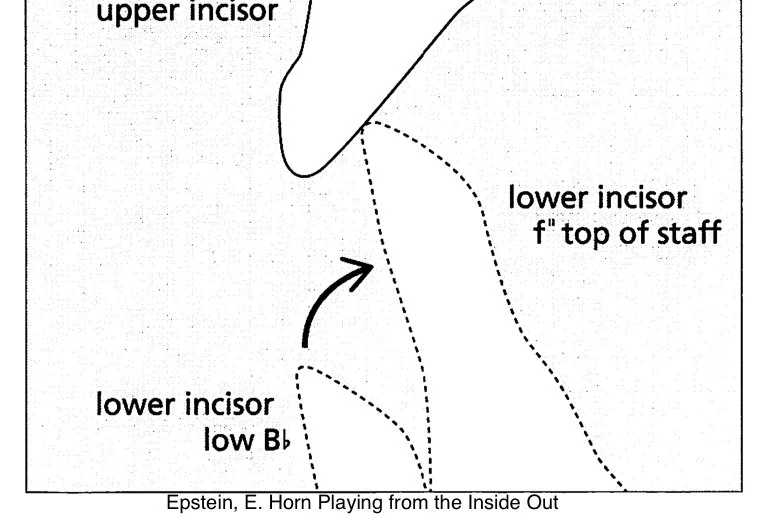Essential Question: How does a brass player expand their range and play different dynamics?
Brass players spend a lifetime refining their tone throughout the range. This lesson introduces the foundational anatomical adjustments necessary to play different notes at different dynamics. Each player will need to experiment and practice to find their best sound. As a teacher, your job is to guide the student in their experimentation and provide constructive feedback and exercises as their sound matures.
Note: though some of these diagrams mention only one brass instrument, the concepts are relevant to all brass playing.
Changing the Shape of the Mouth: “Changing the Vowel Sound”
Just like when we are speaking, we can change the vowel sound by changing the shape of the mouth. Whether the sound is created by the vocal chords or buzzing lips, the mouth shape determines the quality of sound. We change the vowel sound (for speaking and wind playing) by lowering/raising the jaw and adjusting the tongue position.
Using the Jaw and Directing the Air
Dropping the Jaw: To descend into the lower registers of brass instruments, opening the jaw is critical. As the jaw opens, the top and bottom teeth become further apart. Be careful not to overly open the aperture, though, or the buzz will stop.
The Pivot: Changing the direction of the air by pivoting the leadpipe or slightly adjusting your head can facilitate greater control throughout the range.
Generally, a downstream air direction into the horn (leadpipe angled down slightly) facilitates faster sound wave so is useful for the high range
Generally, a straighter air direction into the horn (leadpipe straighter off the lips) facilitates slower sound waves so is useful for low notes
Balancing Air Speed and Lip Tension
Here's an oversimplified, but useful thought experiment.
A note "X" =lip tension+air speed
* If you increase lip tension and keep air speed constant, the pitch will pop up to the next partial higher.
*If you keep the lip tension constant but increase the air speed, the pitch will also pop up to the next partial higher.
*In order to get louder without changing the pitch, you must increase the air speed and compensate with a decrease in lip tension
*To move to a softer without changing the pitch, you must decrease the air speed and compensate by increasing your lip tension.
In reality, the size of the mouth, the jaw position, and volume of air complicate the equation, but this basic idea holds. It's all about finding the right balance of these elements to produce the pitch, sound, and volume you desire.
Helpful Prompts
-
Faster air-- blowing out birthday candles
Imagine a narrower airstream
Increase the lip tension slightly and make the aperture smaller by push the corners forward.
Lift the tongue arch
Tilt the mouthpiece off upper lip slightly
Increase mouthpiece pressure (a little)
Slide the mouthpiece and lips across the teeth slightly (up towards your nose or down away from nose)
Angle the horn leadpipe down slightly
-
Use more air (slower and thicker maybe)
Warmer air—fogging a window, blowing bubbles
Darth Vader air
Drop the jaw, but keep firm corners
Flatten the tongue
Tilt into upper lip slightly
Push jaw forward (maybe)
Slide the mouthpiece and lips across the teeth slightly (up towards your nose or down away from nose)
Angle the leadpipe straighter off your lips
-
Louder
Increase air speed
Allow lip tension to decrease and oral cavity to get bigger as volume and speed of air increase
Remember to listen to the quality of the sound. Don’t overblow it!
Softer
Decrease air speed
Allow lip tension to increase and oral cavity to get smaller as volume and speed of air decrease.
Remember to keep air moving even when playing soft!
-
Hear it: whenever possible, hear the pitch you want to hit. Use the harmonies around you or the last pitch you played to hear the notethe note before you play it
Taste it: often you have to enter on a note without a clear harmonic backdrop. For these notes, you must rely on muscle memory and the feel or "taste" of each note
Practice accuracy and ear training exercises everyday!



